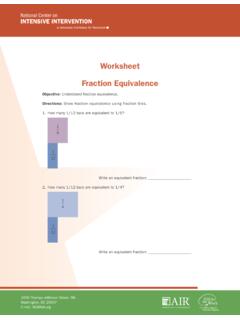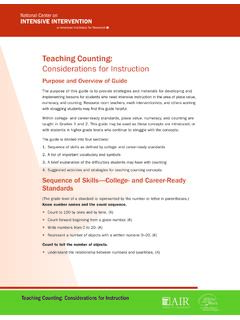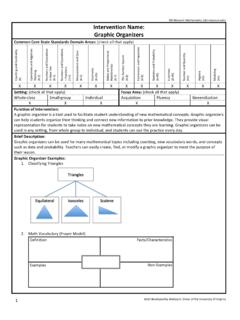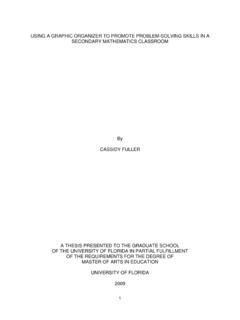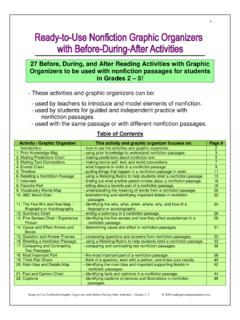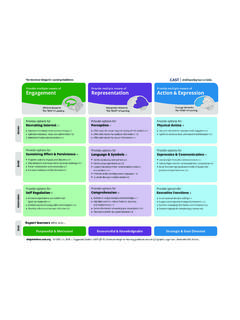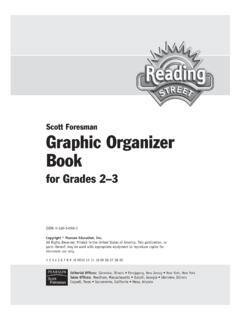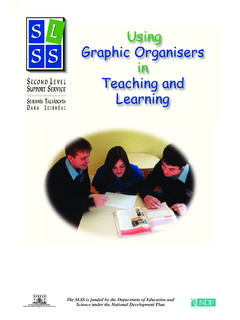Transcription of Graphic Organizers for Text Structures
1 National Center on Intensive Intervention Graphic Organizers for Text Structures 1 2348_08/17 Graphic Organizers for Text Structures Adapted with permission from Denton, C. A., Bryan, D., Wexler, J., Reed, D., & Vaughn, S. (2007). Comprehension. In Effective instruction for middle school students with reading difficulties: The reading teacher s sourcebook (pp. 108 122). Austin, TX: Meadows Center. College- and Career-Ready Standards Addressed: ELA-Literacy RI. and Analyze how a particular sentence, paragraph, chapter, or section fits into the overall structure of a text and contributes to the development of the ideas. Analyze the structure an author uses to organize a : Students will use Graphic Organizers to organize information they read.
2 Materials One narrative and six expository short texts (one text exemplar for each expository text structure ) at the student s instructional level. (Note: The teacher will need to preview the text in advance to select a text that represents the Graphic organizer included in the Text structure Cue Sheet.) Pencil Paper or Notebook Text structure Cue Sheet (this resource is available for download on the National Center for Intensive Intervention [NCII] website)Suggested Schedule and Group Size Schedule: Daily, no more than 5 to 10 minutes per session Recommended group size: Small group, although exact group size will vary depending upon grade level Note: The following script is intended as a model.
3 It is likely that this may take two or three class periods, depending on available minutes of instruction. Activity Intervention Principle Use precise, explicit language to introduce the lesson. Sample Script and Procedures Establish the purpose of using Graphic Organizers to help students organize information for reading comprehension. Good readers use Graphic Organizers to help them organize information they read. A Graphic organizer is a visual diagram that represents the information in the text. Refer students to the Text structure Cue Sheet for visual examples. A Graphic organizer can be used before, during, or after reading to present the information from the text in a visual or Graphic representation.
4 There are many types of Graphic Organizers that can be used to organize information from narrative texts and expository texts . Today we are going to focus on using Graphic Organizers to represent information we read from both narrative text Structures and expository text Structures . National Center on Intensive Intervention Graphic Organizers for Text Structures 2 Activate background knowledge. Remember that the purpose of narrative text is to entertain the reader or present a story. Narrative text will often use one text structure that includes a beginning, middle, and end of a story. The purpose of expository text is to inform the reader of an event or provide general information.
5 Conversely, expository text can use six common types of text Structures within one text. Quick check for understanding. Ask students: What is a Graphic organizer ? [Students should answer: a visual representation of information from the text.] What are the two types of text Structures we will encounter? [Students should answer: narrative text structure and expository text structure .] What are we going to learn today? [Students should answer: using Graphic Organizers to visually represent information we read from both narrative text Structures and expository text Structures .]Use study aides to help students practice applying new information. Introduce the Text structure Cue Sheet to serve as a guide for the students to use while they identify text types, Structures , and Graphic Organizers .
6 Referring to the cue sheet, briefly review the purpose, text structure , definition, and signal words of both narrative text and expository text. Explain to the students that the visual in the Graphic organizer in the right-hand column represents one example of a Graphic organizer for that text structure type. Earlier I told you that we could use different Graphic Organizers to represent the information from the text. Look at the Graphic organizer column on the Text structure Cue Sheet. You can see that each text structure has a different Graphic organizer to visually present the information. Let s look at the Graphic organizer for narrative text structure .
7 The story map Graphic organizer is only one example of a Graphic organizer that we could use to represent the information from a narrative text structure . We could use other Graphic Organizers that include the same information but visually organize the information slightly different. Today we will only use the Graphic Organizers included on the cue sheet. Provide a narrative text at the students instructional level. You might homogeneously group students according to their reading level to present them with the most appropriate text for their reading ability. Provide explicit instruction to teach new concepts. Narrative text structure uses a story structure that includes story elements, such as setting, characteristics, conflict, plot (rising action, climax, falling action), and resolution.
8 Narrative text Structures follow a story plot with a beginning, middle, and end. Let s begin with identifying the type of text we will read and then we ll identify the type of text structure used to help us determine which Graphic organizer is best to represent the information from the text. Group the students in pairs. Hand out the narrative passage. Read the title and continue to read about half of the passage and allow for comment on any graphics in the text, and then transition to partner reading to finish reading the passage. The teacher should monitor the students discussions and text reading. We will read the title together. I will read the first paragraph.
9 Then we will transition to partner reading. Everyone put your finger on the title. Partners check to make sure that you have the correct passage in front of you. Good job. We are all ready to read the title together. Let s begin. The teacher might use choral reading during this activity. National Center on Intensive Intervention Graphic Organizers for Text Structures 3 While reading the text aloud, acknowledge when you encounter a story element in the text. For example, after you read about the setting, explicitly state where the setting of the story is or describe it as the author did. Make the connection that it is important to look for the text structure while reading the text.
10 Upon completion of reading the story, provide a think aloud to help students understand how to accurately identify the text structure . Model think-aloud procedures to demonstrate. I am going to model what I am thinking about while I read the text. This is called a think aloud. The think aloud will depend on the text presented. The teacher will need to preview the text in advance to prepare a think aloud for this activity. An example of a think aloud might include an explanation of the story elements that are present in the text to indicate that the text structure is narrative. Another example of a think aloud might include a reference to the signal words on the cue sheet as another reason to have confidence that the text structure is narrative.
